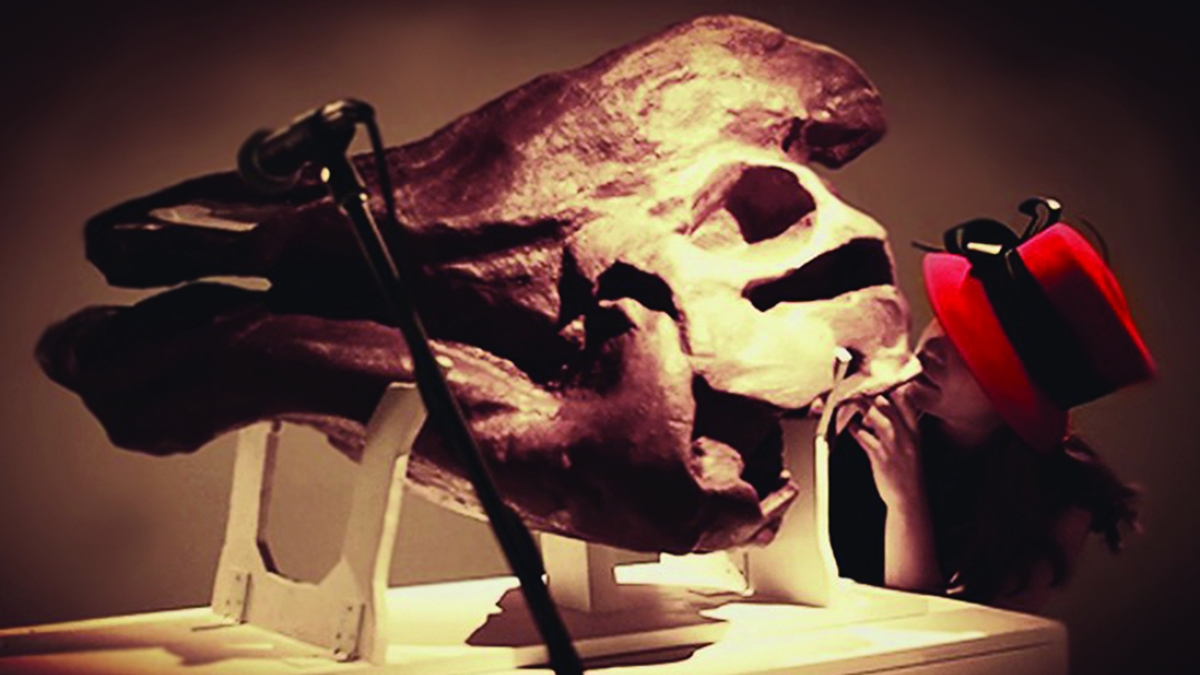ASU grad student receives award for 2015 Best Student Music Submission at the International Computer Music Conference

ASU graduate student Courtney Brown and the Corythosaurus skull she calls Rawr!, the central piece in her transdisciplinary project “Rawr! A Study in Sonic Skulls.”
Photo courtesy of Herberger Institute for Design and the Arts
A panel at the 41st International Computer Music Conference (ICMC) has presented ASU School of Arts, Media + Engineering and School of Music graduate student Courtney Brown the award for 2015 Best Student Music Submission, its annual top student honor, for her original composition “How to Speak Dinosaur: Courtship.”
Brown’s dual background in music and computer science provided the foundation on which she fabricated the Corythosaurus skull she calls Rawr!, the central piece in her transdisciplinary project “Rawr! A Study in Sonic Skulls.”
Brown developed the mechanical larynx and dinosaur design with her DMA advisor, Dr. Garth Paine, associate professor in interactive sound and digital media in the School of Art, Media + Engineering and professor of composition in the School of Music. In August, the Corythosaurus skull prototype was displayed as an interactive sound exhibit at the 2015 Ars Electronica festival in Lintz, Austria. Brown’s project had been awarded a Prix Ars Electronica honorary mention, one of the most prestigious media arts honors in the world.
Brown noted that the composition was the start of the work she had done in developing a performance practice for Rawr!, “a lot of which is based on call and response, and, of course, on the narrative elements.” She also used extra mouthpieces (a bassoon reed and a tuba mouthpiece) to create different sounds.
“This work was composed for the tubist David Earll, and his work on the piece was an integral part of it, especially his skill with extended techniques,” Brown says. “David was an ASU DMA tuba student at the time, and he now teaches low brass at the University of Wisconsin-Platteville.”
She adds, “James DeMars was my composition professor at the time. It was he who suggested the tuba, and David (as a player) in particular. Originally, I was thinking of the trombone. Before I wrote this piece, I wasn’t aware of the tremendous flexibility and variety of timbres that the tuba could produce. It is very good at low dinosaur-like sounds.”
Before she could compose the piece, Brown had to first construct the skull prototype, engaging in hard science research in order to create an instrument that could emit an accurate sound. Discovering the Corythosaurus voice started with piecing together the skull itself.
“The skull is created from CT scans. The inside is a little more faithful than the outside,” Brown explains. “One side was crushed. It’s actually a mirror image of the two sides, so we have a whole Corythosaurus skull, a standing object that was created with 3D printing. When you create something like this from digital fabrication, there are limitations. The skull is as faithful as it could be within the limitations that we had.”
The next set of design constraints involved the dinosaur’s vocalization mechanisms.
“The mechanical larynx is as scientifically accurate as it can be considering that after 77 million years, there are no soft-tissue remains. But through the research we did, I can tell you that in vocalizing creatures, your hearing range is tuned to your own voice; therefore, assuming that these dinosaurs were vocalizing creatures, I could look at their hearing.” Brown says she knows that the dinosaurs could hear because there are remains of the cochlea. “In archosaurs, which include birds and reptiles, the length of the cochlea corresponds to the range of best hearing... you have the frequency of best hearing, and the limit of their hearing. The frequency of best hearing is 267 hertz.” The larynx Brown made was developed according to such specifications.
And what of the composition itself?
“That’s my compositional conceit,” Brown says. “I used crocodiles for inspiration, as crocodiles are the hadrosaurs’ closet living relatives. The challenge was that crocodiles actually originated their sounding larynx. Their ancestors had larynges, but they weren’t used for sound. The sounds they make are amazing. Just the idea of them responding to thunder amorously, I think, is very humorous. It kind of gave me a window to create this piece. This is kind of like a ‘Hello, world’ piece for the dinosaur.”
Brown doesn’t take for granted the accolades she’s received for her work.
“The ICMC award was a surprise and an honor,” she says. “I'm thrilled to receive international recognition for my work, and grateful for the support of the School of Arts, Media + Engineering, the School of Music and ASU and their support via a Student Enrichment Grant to attend the conference.”
“How to Speak Dinosaur: Courtship” is an original music composition written by Courtney Brown for hadrosaur skull (Courtney Brown) and tuba (David Earll).
Media Contact:
Kristi Garboushian
School of Arts, Media + Engineering
480.727.1161
kristi.garboushian@asu.edu